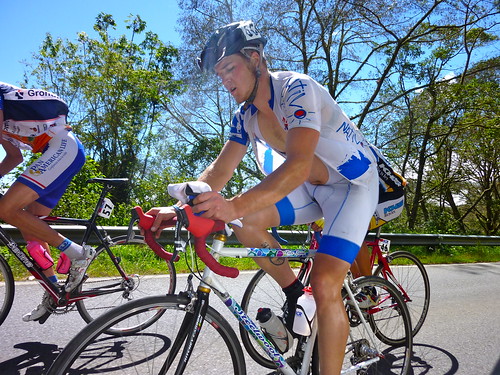 |
| Ryan Atkins atop his Steelwool in a pretty serious stage race. |
Humans tire; the question is: how fast? Heine discusses his findings: stiffer and lighter bikes are not faster by virtue of these factors. Rather, they seem to fatigue the rider sooner (due to lack of yielding to the power input), reducing the overall power available for propulsion. Heine thus tacitly references planing. The titanium bike in his experiment does not harmonize with his body's pedaling rhythm, but instead loads his legs with lactic acid prematurely. He is not able to produce as much power on the lighter, stiffer bike. This is thus a slower bike than its heavier steel counterpart.
One might blame perceptual bias, but I suspect Heine's protocols are sound. Heine and his co-tester, Mark, ride steel bikes a lot. They are attuned to the rhythm and resonance of 'flexy fliers.' They know how to work with them. The both believe they are fast bikes, and prove it by riding them fast. On stiffer bikes they are less efficient. At the same time, riders who have grown up riding stiff bikes believe they are faster. These riders are attuned to the resonance of stiff bikes, and feel slower on bikes that yield more to their input. Feeling slower can mean you are slower; the rider's perception of speed versus effort can either enhance or diminish one's power output. That is, if you feel like a hero, you can eke out more power. In contrast, if you feel like a 'zero,' access to your power will be diminished; you will undermine your ability. Cue the excuses.
In the final analysis, I would contend that the fastest bike for a given rider is that which harmonizes with the rider's belief and ability. PRO racers probably really are faster on ultra stiff bikes than they would be on lively steel rigs (it would be fascinating to involve PRO racers in the same experiment Heine undertook).
Rando masters like Jan Heine probably really are faster on flexy, heavier bikes. When you get down to the bottom of the matter, there is no one set of design parameters that is ideal for ALL riders. A great bike is one that the rider feels comfortable and fast on, regardless of how that is accomplished. If you want to change it up, you are going to have to be willing to take the time to get intimate with a new platform in order to get the most from it.
This said, 23mm tires really are slower than 25s on the road. ;)


3 comments:
Up to this point, I've only read opinions that are yay or nay on Heine. You put him in a fair context and argue well that things are more nuanced than folks admit. 'Planing' or whathaveyou has as much to do with the rider as the bike. This is reasonable.
One might extend this to the fat vs skinny tire debate. fwiw I'm not strong enough to be fastest on 650b balloons, fat 700c is ideal for me.
Thanks for reading, and your comments, Steve. I have to give credit to my team-mate, Iain Radford, for his insights on this subject. It was through interrogating the topic with Iain that I was able to work through this nuance...or so I hope I've done.
I'm intrigued by your comment regarding 650B balloons, as I'm under the impression that they carry speed very well. However, not having ridden them, I'll have to wait until I have opportunity to spend hours on them to testify. I suspect that one's riding style dictates one's judgement of the format. That is, a punchy rider might prefer the lower weight of a 700c wheelset for sharp accelerations, while a rouleur might prefer the steady speed of 650bs. Speculation at this point, I look forward to doing some testing down the road.
I believe this subject is much more important than others that dominate discussions on bike performance.
For Jan Heine, his large tyres will flex earlier than the frame will so he will only experience planing (I prefer the term springing) on a flexible bike.
The next issue is muscle make-up. I am a former sprinter and my legs were composed of all the wrong fibres for cycling so I am not fast except on a short sprint. On a 1990s Tomassini, I could only get the frame to spring when I was above 95% sprint effort, an output that most adult cyclists would never reach because their muscle fibres are too slow. That said, this Tomassini was the slowest bike I ever rode. It would simply not store the uneven pulses from my legs when riding at normal speeds.
By contrast, I have had several touring bikes that spring much more readily and these have been the fastest bikes for me in all practical terms. One was Tange Mangalloy 2000 and one was 531 ST.
Unlike the Tomassini, they are kinder over a much wider range of effort and do not suddenly spring at a certain point.
I once tested a 531C Evans (London) in about 1990, which was beautifully springy but I was not in the market at the time.
So now I ride a 708 Mercian, hoping that the 753 triangle and forks would give me enough spring. They don't - 708 is too rigid for the main tubes.
There is such a thing as too springy and I have a shed full of old 531 frames with narrow pencil stays with lots of offset and trail.
In short, there is much more to matching rider and frame that forums generally appreciate and much more to offer from steel than this "steel is real" slogan which keeps turning up.
Post a Comment